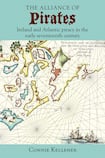
In the shorthand view of Irish history the Battle of Kinsale marks the collapse of Gaelic Ireland and the final assertion of English control over the whole country. The townspeople of Kinsale may have seen it rather differently: in the decade after the battle, west Cork achieved international notoriety as a centre of piracy and a safe haven for the disposal of stolen cargoes.
Such flagrant piracy was a measure of the feebleness of the Irish state. Over the next 20 years there was neither effective legal sanction nor adequate naval strength to disperse what became a veritable private flotilla.
Piracy history has been late in coming to Ireland, but interest in the subject has generated excellent popular studies (notably by Des Ekin) and substantial academic research (led by John Appleby). Most of this has focussed on the southwest and on the early 17th century. Connie Kelleher has played her part, and she is something of an amphibian – at home under the waves as a professional underwater archaeologist, and as a 17th century historian trained in Jane Ohlmeyer’s stable.
The Alliance of Pirates is an admirably comprehensive survey of this literature, and by exploiting crucial English archival evidence adds much that is new. Its appearance now as a sumptuously illustrated and moderately priced publication is an indication that pirate history sells – and so it should.
It is, however, a difficult story to tell. Kelleher approaches it thematically. Perhaps a chronological narrative would have made it easier to follow. And the evidence, some of it drawn from officialdom covering its tracks, some from legal examinations and depositions that cannot be corroborated, is tantalising but often incomplete, sometimes contradictory. Kelleher is forced to speculate much of the time.
New regime
However, what prompted it all is made clear. After a generation of publicly sanctioned and privately-financed English piracy directed against Spanish shipping, all changed in 1603. A new regime in London sought detente with Spain, the (small) royal navy was partially decommissioned, and privateering was outlawed in the king’s dominions.

But not quite: there was a huge exodus of veteran pirates and privateers, principally from the English West Country, across to the familiar waters of west Cork.
Thereupon upwards of 50 pirate captains began to operate from Baltimore and points westwards. They exploited the sheltered natural harbours and modest inshore islands of Roaringwater Bay, a seascape that was treacherous for those unfamiliar with the approaches.
Kelleher argues that this swarm of pirates constituted themselves into an alliance, a confederation that respected certain ground rules and codes of behaviour. The evidence for this is circumstantial, although it is entirely plausible that practices developed among privateers in Elizabethan England would have been carried across after 1603.
The arrival and successful encampment of up to several thousand English people in an entirely Gaelic Irish district may seem a little surprising. Kelleher finds no evidence of tensions on land, rather the willing co-operation of the indigenous population in servicing the multiple bodily needs of the seamen. This exchange was helped no doubt by the circulation of newly affordable exotic goods (from pepper and cloves to sugar and camphor oil) coming from the vessels stripped by the pirates.
Piracy was by its nature multi-ethnic. The names associated with west Cork piracy – Bishop and Baugh, Ward and Easton – were English, but other nationalities, notably Dutch and Flemish veterans, were heavily involved.
And it was an official Dutch operation against west Cork pirates, sanctioned by King James himself, that led to one of the bloodiest attempts to close down their activities in 1614: in a surprise attack on Crookhaven some 30 were killed, including the much-travelled pirate captain Patrick Myagh.
Dutch shipping
Myagh was almost certainly Cork-born, which was unusual. He had been involved in attacks on Dutch shipping off Morocco and had operated out of Mamora (modern Mehdia). Together with other Moroccan Atlantic ports, this African Baltimore had served as a victualing point and safe retreat for northern European pirates hunting Dutch goods from east Asia and Spanish treasure from the west. However, by the 1620s indigenous sailors in these north African ports had incorporated English and Dutch expertise. They became increasingly active Atlantic pirates in their own right, as west Cork would soon find out.
Piracy may indeed have been the major driver of colonisation on that frontier before being overtaken by the burgeoning pilchard trade in the 1620s
Why were there so few Irish involved in this “alliance of pirates”? Perhaps there were many unrecorded deckhands, yet few if any Irish-born sailors became wealthy freebooters at home. But the principal reason is side-stepped here: the second wave of the Munster Plantation.
The Nine Years War (1595-1603) had nearly destroyed the first English settlements on the forfeited Desmond lordship, but after the war sustained English immigration and capital investment in the province proved highly disruptive of old ways and old elites.
Not unrelated to this was the huge migration after Kinsale to Spain, to La Corunna and beyond, of the retainers and supporters of O’Sullivan Beare and the O’Driscoll lords among others, draining parts of west Cork of young adults.
Perhaps empty land stimulated colonisation on the frontier; certainly a few of the newcomers entering the province exploited opportunities outside the specific zones of the plantation, turning to the oak forests of south Kerry, the fisheries of west Cork, and to the trade in pirated goods. Piracy may indeed have been the major driver of colonisation on that frontier before being overtaken by the burgeoning pilchard trade in the 1620s.
Newcomer
One unusually well-documented newcomer is William Hull. Kelleher deploys her fieldwork research to recreate the world he created beyond Schull at Leamcon. From a trading background in Exeter, Hull was on the ground in west Cork far longer than most – from around 1607 until his death in 1643. Almost certainly a pirate and the willing host of pirates in the early years, he was a master at playing a double game.
Hull exploited confused lines of admiralty authority and defects in the Irish statute law on piracy. He became a client, an agent and then a kinsman of Richard Boyle, who was the elemental force then driving the colonial development of south Munster.
Hull’s Leamcon graduated from pirates’ retreat to a recognisd hub of legitimate trade. There are still traces of harbour infrastructure and of the many “fish palaces” erected to press and salt the precious pilchards being prepared for shipment to continental markets.
Baltimore was indisputably a colonial enclave, Puritan and, by then, law-abiding. Was there a hidden agenda behind the decision to ravage it?
Hull was the canniest survivor, but Kelleher notes how other pirate leaders negotiated their way to pardons and a quieter life. Seasonal employment in the fishery may have helped lesser folk to build a second life after piracy. Hundreds settled in and around Baltimore.
And it was there that the most sensational piratical incident occurred in 1631: a renegade Dutchman, Murad Reis, led a night-time raiding party of Algerian pirates that led to the capture and subsequent enslavement of over 100 townspeople. Kelleher suggests that one ex-pirate family may have been among these captives, and it seems entirely plausible that there were others.
Baltimore was indisputably a colonial enclave, Puritan and, by then, law-abiding. Was there a hidden agenda behind the decision to ravage it? Kelleher, perhaps wisely, doesn’t speculate on this, but notes that the town never fully recovered. But the sack of Baltimore prompted the first really intense crackdown on piracy by the earl of Strafford’s government.
Rebellion
And then, with the 1641 rebellion and the collapse of central government, something akin to mass piracy flared up again. This time it was centred on Wexford.
It is a pity that Kelleher’s brief did not extend to a discussion of that episode. Sponsored by the Confederate Supreme Council, the Wexford privateers were initially outsiders (from Dunkirk principally), were fairly indiscriminate in their predations, and brought momentary wealth to the port that hosted them. Irish captains were not as rare as they had been in west Cork, and the crews were probably even more strongly local.
This flotilla of armed frigates vanished after Cromwell’s capture of Wexford in 1650. At their peak they were probably comparable in offensive capability with the west Cork “alliance” of a previous generation, but they left even fewer traces behind them than did Kelleher’s buccaneers.
David Dickson’s latest book, The First Irish Cities: An Eighteenth-Century Transformation, will be published next spring.










